DTC B1423/23 Pressure Sensor Circuit |
| DTC No. | DTC Detection Condition | Trouble Area |
| B1423/23 |
|
|

| 1.CHECK HARNESS AND CONNECTOR (POWER SOURCE CIRCUIT) |
 |
Disconnect the A/C pressure sensor connector.
Measure the voltage according to the value(s) in the table below.
| Tester Connection | Switch Condition | Specified Condition |
| A31-3 (+) - Body ground | Power switch on (IG) | 4.75 to 5.25 V |
| *1 | Front view of wire harness connector (to A/C Pressure Sensor) |
|
| ||||
| OK | |
| 2.CHECK HARNESS AND CONNECTOR (GROUND CIRCUIT) |
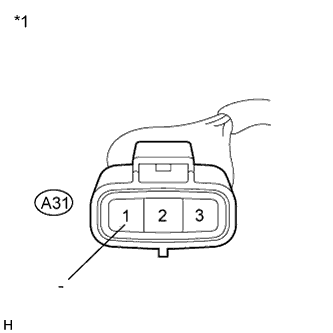 |
Measure the resistance according to the value(s) in the table below.
| Tester Connection | Condition | Specified Condition |
| A31-1 (-) - Body ground | Always | Below 1 Ω |
| *1 | Front view of wire harness connector (to A/C Pressure Sensor) |
|
| ||||
| OK | |
| 3.INSPECT A/C PRESSURE SENSOR (SENSOR SIGNAL CIRCUIT) |
Reconnect the A/C pressure sensor connector.
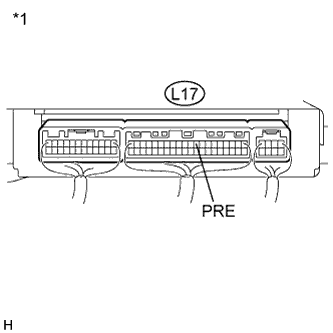 |
Remove the A/C amplifier with the connectors still connected.
Measure the voltage according to the value(s) in the table below.
| Tester Connection | Condition | Specified Condition |
| L17-9 (PRE) - Body ground | Power switch on (IG) (A/C: off) | 0.73 to 4.84 V |
| *1 | Component with harness connected (A/C Amplifier) |
|
| ||||
| OK | |
| 4.INSPECT A/C PRESSURE SENSOR (SENSOR SIGNAL CIRCUIT) |
Measure the voltage when the following conditions are satisfied.
| Item | Condition |
| Vehicle Doors | Fully open |
| Temperature Setting | MAX COLD |
| Blower Speed | HI |
| A/C Switch | on |
| R/F Switch | RECIRCULATION |
| Interior Temperature | 25 to 35°C (77 to 95°F) |
 |
Measure the voltage according to the value(s) in the table below.
| Tester Connection | Condition | Specified Condition |
| L17-9 (PRE) - Body ground | Power switch on (IG) (A/C: on) | 0.73 to 4.84 V |
| Result | Proceed to |
| OK (When troubleshooting according to the DTC) | A |
| OK (When troubleshooting according to Problem Symptoms Table) | B |
| NG | C |
| *1 | Component with harness connected (A/C Amplifier) |
|
| ||||
|
| ||||
| A | ||
| ||
| 5.CHECK HARNESS AND CONNECTOR (A/C AMPLIFIER - A/C PRESSURE SENSOR) |
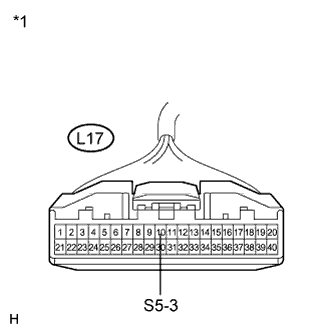 |
Disconnect the A/C amplifier connector.
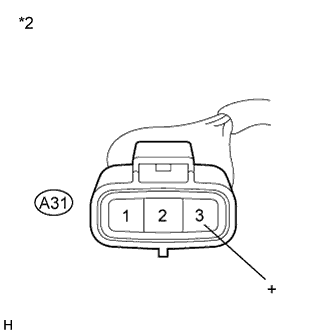 |
Measure the resistance according to the value(s) in the table below.
| Tester Connection | Condition | Specified Condition |
| A31-3 (+) - L17-10 (S5-3) | Always | Below 1 Ω |
| L17-10 (S5-3) - Body ground | Always | 10 kΩ or higher |
| *1 | Front view of wire harness connector (to A/C Amplifier) |
| *2 | Front view of wire harness connector (to A/C Pressure Sensor) |
|
| ||||
| OK | ||
| ||
| 6.CHECK HARNESS AND CONNECTOR (A/C AMPLIFIER - A/C PRESSURE SENSOR) |
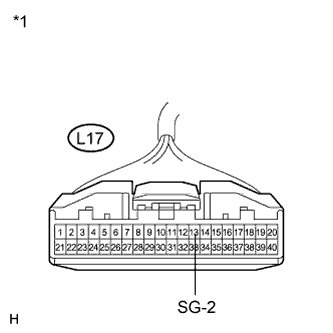 |
Disconnect the A/C amplifier connector.
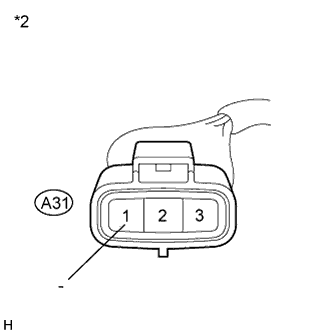 |
Measure the resistance according to the value(s) in the table below.
| Tester Connection | Condition | Specified Condition |
| A31-1 (-) - L17-13 (SG-2) | Always | Below 1 Ω |
| L17-13 (SG-2) - Body ground | Always | 10 kΩ or higher |
| *1 | Front view of wire harness connector (to A/C Amplifier) |
| *2 | Front view of wire harness connector (to A/C Pressure Sensor) |
|
| ||||
| OK | ||
| ||
| 7.CHECK HARNESS AND CONNECTOR (A/C AMPLIFIER - A/C PRESSURE SENSOR) |
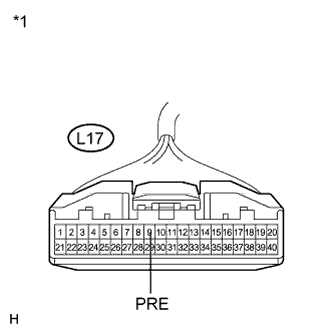 |
Disconnect the A/C amplifier connector.
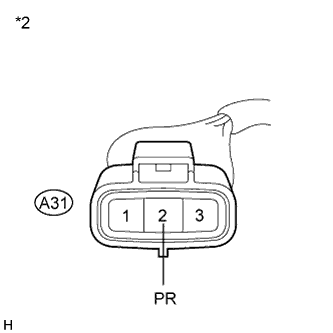 |
Measure the resistance according to the value(s) in the table below.
| Tester Connection | Condition | Specified Condition |
| A31-2 (PR) - L17-9 (PRE) | Always | Below 1 Ω |
| L17-9 (PRE) - Body ground | Always | 10 kΩ or higher |
| *1 | Front view of wire harness connector (to A/C Amplifier) |
| *2 | Front view of wire harness connector (to A/C Pressure Sensor) |
|
| ||||
| OK | |
| 8.CHECK FOR A/C SYSTEM LEAK |
Install the manifold gauge set.
Recover the refrigerant from the A/C system using a refrigerant recovery unit.
Evacuate the A/C system and check that vacuum can be maintained.
|
| ||||
| OK | |
| 9.CHARGE REFRIGERANT |
Add an appropriate amount of refrigerant (Click here).
| NEXT | |
| 10.RECHECK FOR DTC |
Recheck for the DTC when the following conditions are satisfied.
| Item | Condition |
| Vehicle Doors | Fully open |
| Temperature Setting | MAX COLD |
| Blower Speed | HI |
| A/C Switch | on |
| R/F Switch | RECIRCULATION |
| Interior Temperature | 25 to 35°C (77 to 95°F) |
| Result | Proceed to |
| DTC B1423/23 is output | A |
| DTC B1423/23 is not output | B |
|
| ||||
| A | |
| 11.INSPECT A/C PRESSURE SENSOR |
Install the manifold gauge set.
Reconnect the A/C pressure sensor connector.
Turn the power switch on (IG).
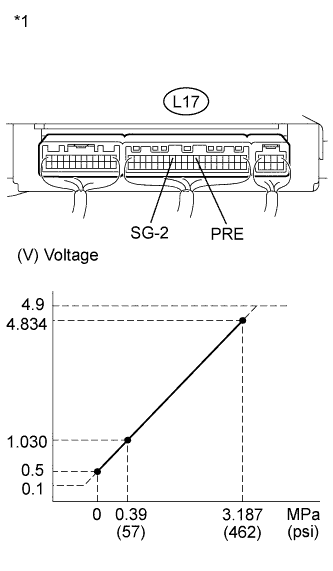 |
Measure the voltage according to the value(s) in the table below.
| Tester Connection | Condition | Specified Condition |
| L17-9 (PRE) - L17-13 (SG-2) | Refrigerant pressure: Normal pressure (less than 3.187 MPa [462 psi] and more than 0.39 MPa [57 psi]) | 1.0 to 4.912 V |
| *1 | Component with harness connected (A/C Amplifier) |
|
| ||||
| OK | ||
| ||
| 12.REPAIR A/C SYSTEM LEAK |
Identify the area where refrigerant leaks from (Click here).
Repair the identified area of the A/C system.
Evacuate the A/C system.
| NEXT | ||
| ||
| 13.INSPECT COOLING FAN SYSTEM |
Check that the cooling fan(s) operates normally.
|
| ||||
| OK | |
| 14.CHARGE REFRIGERANT |
Use a refrigerant recovery unit to recover refrigerant.
Evacuate the A/C system.
Add an appropriate amount of refrigerant (Click here).
| NEXT | |
| 15.RECHECK FOR DTC |
Recheck for the DTC when the following conditions are satisfied.
| Item | Condition |
| Vehicle Doors | Fully open |
| Temperature Setting | MAX COLD |
| Blower Speed | HI |
| A/C Switch | on |
| R/F Switch | RECIRCULATION |
| Interior Temperature | 25 to 35°C (77 to 95°F) |
| Result | Proceed to |
| DTC B1423/23 is output | A |
| DTC B1423/23 is not output | B |
|
| ||||
| A | |
| 16.REPLACE EXPANSION VALVE |
Replace the expansion valve with a new or a known good one (Click here).
| NEXT | |
| 17.CHARGE REFRIGERANT |
Add an appropriate amount of refrigerant (Click here).
| NEXT | |
| 18.RECHECK FOR DTC |
Recheck for the DTC when the following conditions are satisfied.
| Item | Condition |
| Vehicle Doors | Fully open |
| Temperature Setting | MAX COLD |
| Blower Speed | HI |
| A/C Switch | on |
| R/F Switch | RECIRCULATION |
| Interior Temperature | 25 to 35°C (77 to 95°F) |
| Result | Proceed to |
| DTC B1423/23 is not output | A |
| DTC B1423/23 is output | B |
|
| ||||
| A | ||
| ||
| 19.REPLACE A/C PRESSURE SENSOR |
Replace the A/C pressure sensor (Click here).
| NEXT | |
| 20.RECHECK FOR DTC |
Recheck for the DTC when the following conditions are satisfied.
| Item | Condition |
| Vehicle Doors | Fully open |
| Temperature Setting | MAX COLD |
| Blower Speed | HI |
| A/C Switch | on |
| R/F Switch | RECIRCULATION |
| Interior Temperature | 25 to 35°C (77 to 95°F) |
| Result | Proceed to |
| DTC B1423/23 is not output | A |
| DTC B1423/23 is output | B |
|
| ||||
| A | ||
| ||